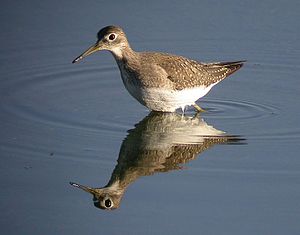Lone water strider
| Lone water strider | ||||||||
|---|---|---|---|---|---|---|---|---|

Lone water strider ( Tringa solitaria ) |
||||||||
| Systematics | ||||||||
|
||||||||
| Scientific name | ||||||||
| Tringa solitaria | ||||||||
| Wilson , 1813 |
The solitary water strider ( Tringa solitaria ) is a species of bird in the family of snipe birds. Several subspecies are distinguished. The IUCN classifies the lonely water strider as harmless ( least concern ).
Appearance
The lonely water strider reaches a body length of 18 to 21 centimeters. The wingspan is 55 to 60 centimeters. The weight varies between 35 and 60 grams.
In breeding plumage Solitary Sandpipers have an olive-brown head, which is fine dashed white. The white stripe above the eyes is only clearly visible in front of the eye. A second, darker stripe runs underneath. The chin, throat and underside of the body are pale grayish white, the chest is clearly dashed dark brown. In the simple dress , the head and the chest are more gray-brown, the dashed lines are clearly reduced.
The iris is dark brown. The black beak is thin and narrow and lightens to a pale green at the base of the beak. The legs and feet are olive or greyish green.
Young birds are darker on the head and chest. There are numerous small, whitish spots on the upper side of the body. Downy chicks are spotted brown, gray and black on the top of their bodies.
Distribution area
The lonely water strider is a nearctic species. It breeds mainly in central Alaska, and is relatively rare on the west and north coast of Alaska. As a habitat it prefers rivers and wetlands in forests. It is a mandatory migratory bird that overwinters in eastern Central America, the Caribbean, and South America.
Way of life
The solitary water strider mainly eats invertebrates, amphibians and small fish. It finds its food by whirling up the water with its feet and pecking food from the surface of the water. He pokes less often in shallow water and moist substrate.
Solitary water striders usually live solitary. Groups of more than three individuals are rare. The animals show an aggressive behavior towards birds of other species. Solitary water striders usually enter into a monogamous seasonal marriage. As a nesting site, they usually use the abandoned nests of other bird species, especially those of thrushes, and breed up to heights of 13 meters above the ground. The clutch usually consists of four eggs. These are incubated by both parent birds for a period of 22 to 24 days. The chicks flee the nest. So far, the chicks have not been observed to leave nests high in the trees. The young birds fledge after 18 to 21 days.
Web links
- Tringa solitaria inthe IUCN 2013 Red List of Threatened Species . Listed by: BirdLife International, 2012. Retrieved October 27, 2013.
supporting documents
literature
- Richard Sale: A Complete Guide to Arctic Wildlife. Christopher Helm Publisher, London 2006, ISBN 0-7136-7039-8 .
